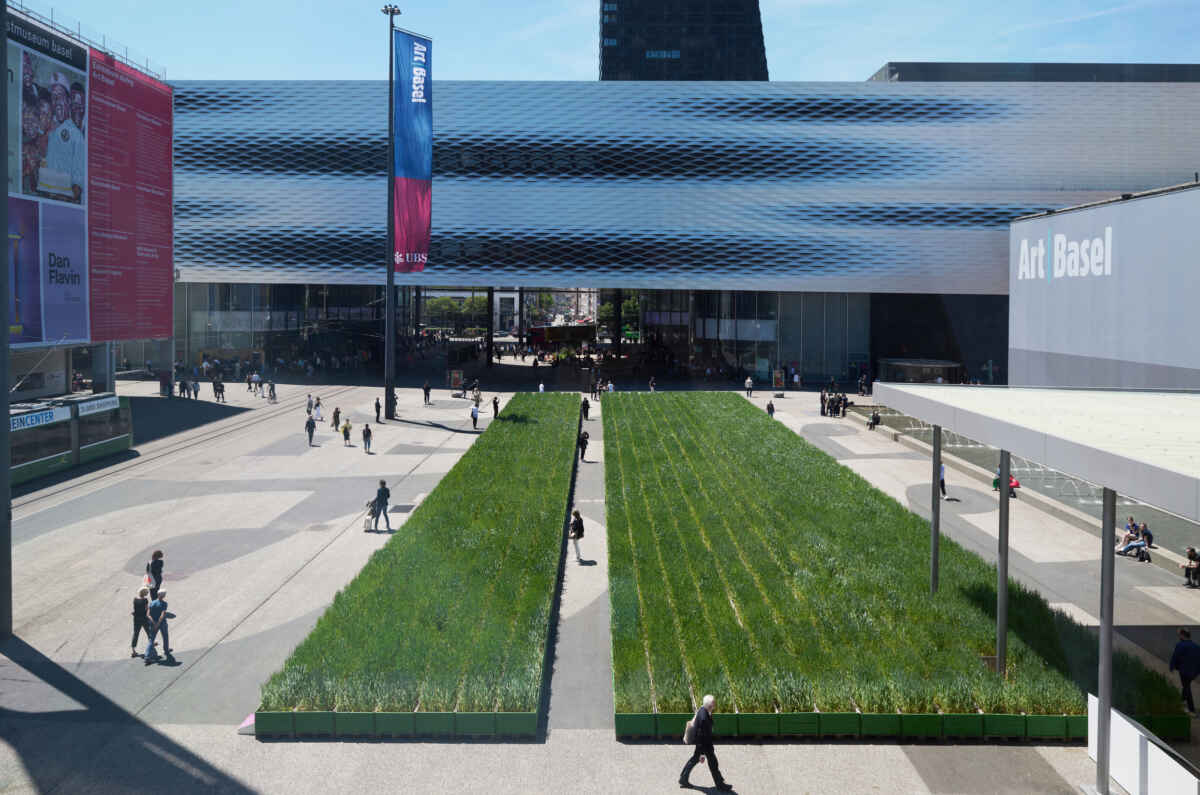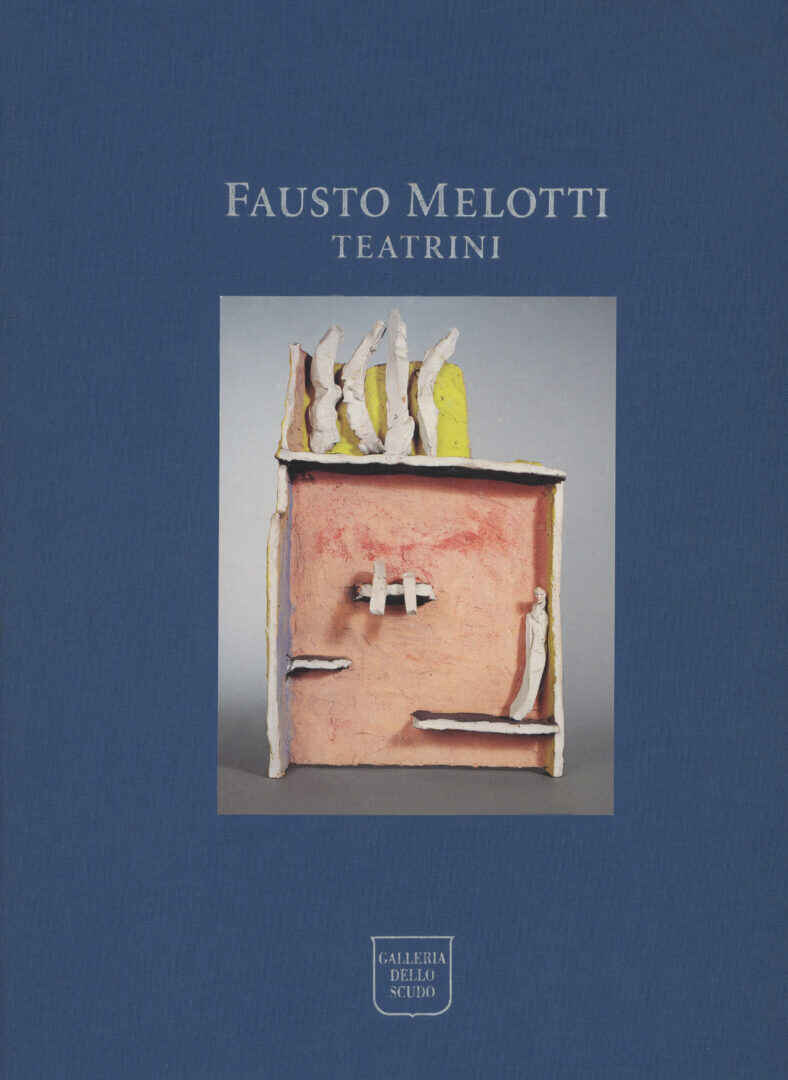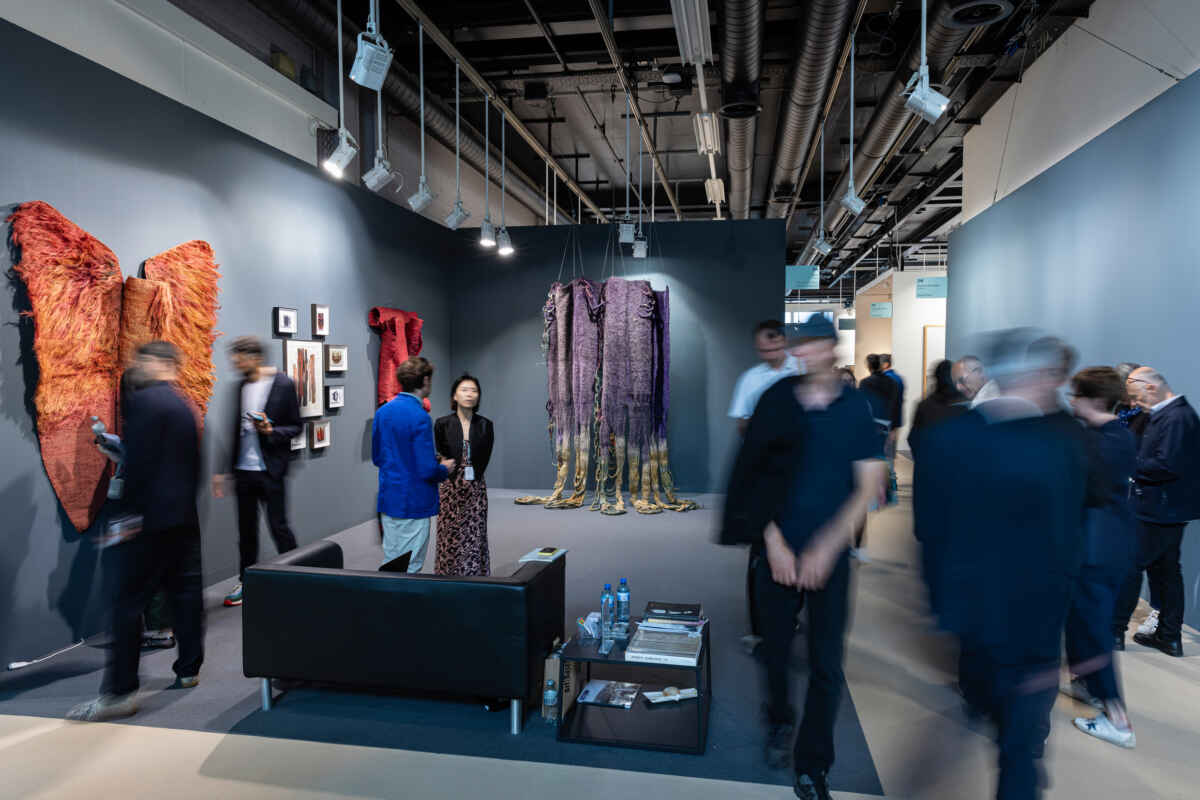
A giant work by the eco-pioneer and landart master Agnes Denes, born in Budapest in 1931, ornates the Art Basel entrance at Messeplatz (photograph on top of this page). In 1982, she had created Wheatfield – A Confrontation. Back then, the iconic environmental work sponsored by the Public Art Fund pitted two acres (8,000 square meters) of golden wheat planted and harvested in the shadow of New York’s Twin Towers against the hydra-headed hegemons of money, politics, global trade, and ecological indifference. 42 years later – after worsening climate change and pollution – her work, adapted to the Art Basel 2024 space, appears more prescient than ever.
The grain Agnes Denes and her volunteers had harvested from the original New York City Wheatfield – A Confrontation later traveled to 28 cities in The International Art Show for the End of World Hunger and was later planted and sown around the globe.

Impression of Art Basel 2024. Photograph copyright © courtesy Art Basel 2024.
At the end of my visit, I had a look at the Unlimited sector of Art Basel, in 2024 curated by Giovanni Carmine. Staged across a 16,000 square meters, it featured monumental artworks, immersive contemporary installations, murals created in situ, three performances and a great exhibition of historical photographs by Robert Frank.
Robert Frank was born in Zurich in 1924 and died in Inverness, Canada, in 2019. To commemorate the artist’s centenial, Unlimited showed the 83 photographs of his iconic monograph The Americans (1954-1957).
During a two-year trip across the United States, Robert Frank took over 28,000 black-and-white photographs. The 83 works from his seminal book presented by Art Basel were printed in 1983 by photographer Ed Grazda under the supervision of Robert Frank. They were made for Frank’s own archive. At Unlimited, they were exhibited for the first time, thanks to a joint effort by Galerie Thomas Zander and Pace Gallery. It is the last available complete printed set of The Americans.
Pace Gallery is famous for holding decades-long relationship with artists such as Alexander Calder, Jean Dubuffet, Mark Rothko and others.
At Art Basel 2024, I spotted several works by Robert Frank for sale, notably at Pace Gallery and Galerie Thomas Zander. In addition, Pace Gallery had a glorious Dubuffet on offer: Pommettes Rouges (1958; oil on canvas; 71 x 100 cm).
One of my favorite galleries, Landau Fine Art, offered several works by Jean Dubuffet, notably one of the famous Barbus Müller sculptures, Le nez tombant (1959, papier mâché, 31 x 12 x 10.5 cm), in addition to paintings, among them Portrait d’homme moustachu façon carton pâte (1946, oil and mixed media on board, 59.5 x 50 cm) as well as Arabe au fusil (1948, oil on canvas, 92 x 73 cm).
Back to Unlimited. The giant yellow sculpture with black dots, Aspiring to Pumpkin’s Love, the Love in my Heart (2023), presented by David Zwirner, was sold to an American private collection for $5 million. The monumental sculpture by the Japanese artist Yayoi Kusama (*1929) depicts two interconnected bronze pumpkins with undulating surfaces, augmented by lines of Kusama’s signature dots. The artist has used pumpkins to represent themes of infinity, fertility and the sublime. Kusama first encountered a pumpkin as a child at her family’s plant nursery, and when she went to pick it, it supposedly began speaking to her. She soon painted the pumpkin and won her first prize – at the age of 11. Ever since, ‘pumpkins have been a great comfort to me,’ the artist has said. ‘They speak to me of the joy of living. They are humble and amusing at the same time, and I have and always will celebrate them in my art.’ So far what one could read at Unlimited.
Born in the city of Matsumoto, she studied for one year at Kyoto City University of Arts, where she was trained in the traditional japanese Nihonga style, which uses mineral pigments, occasionally ink, together with other organic pigments on silk or paper (for more, check the book by Eve Loh Kazuhara: Nihonga, 2016). Yayoi Kusama has influenced artists such as Andy Warhol, Claes Oldenburg and others. She suffers from obsessive-compulsive disorder and hallucinations and has been living voluntarily in a psychiatric clinic for decades.

Other notable artists and œuvres at Art Basel 2024 include Sunil Gupta’s series Exiles (1986), exhibited by Vadehra Art Gallery. Notable sales include Joan Mitchell’s diptych Sunflowers (1990–91), which David Zwirner gallery managed to sell for $20 million. Hauser & Wirth sold Arshile Gorky’s Untitled (Gray Drawing (Pastoral)) (circa 1946–47), a charcoal and pastel work on paper, for $16 million.
Two delicate, playful sculptures by Fausto Melotti (1901-86) were for sale for $350,000 each at Galleria dello Scudo. My favorite of the two Melotti’s was Il grande pesce appare (1984; brass, glass, 73 x 57 x 35 cm), a reference to the Biblical tale of the creature that swallowed Jonah; it is often depicted in art and culture as a whale, the Hebrew text uses the phrase “large fish” (hence the title: il grande pesce).
Another work by Fausto Melotti was on view at Hauser & Wirth: La pioggia (1966, 1970), gold, made in an edition of 3 + 1 AP, 61 x 29 x 18 cm.
Two notable books on Fausto Melotti by Galleria dello Scudo:
– Fausto Melotti. Sculture 1967-1985, Galleria dello Scudo, Verona, 20 April – 30 May 1991, catalogue, text by Serge Fauchereau Paperback Size 27,7 x 20,8 x 0,4 cm 10 ill. col. 40 pages.
– Fausto Melotti. Teatrini 1931-1985, curated by Carlo Pirovano, Galleria dello Scudo, Verona, 15 December 1996 – 28 February 1997, catalogue, essays by Fabrizio D’Amico, Rudy Fuchs and Carlo Pirovano, catalogue of the works curated by Carlo Pirovano, biography and biographical and bibliographical research by Laura Lorenzoni. Hardback Size 30,6 x 24,5 x 2,3 cm 59 plates, 76 ill. b/w 208 pages. Edizioni Galleria dello Scudo, Verona, 1996.
About Fausto Melotti, read also my review of Art Basel 2021. Incidentally, his nephew, the son of his sister Renata Melotti and architect Gino Pollini, was none other than the great classical pianist Maurizio Pollini.
When I walked around the booth of Landau Fine Art on Wednesday, the gallery offered once again great works by my fellow Swiss Alberto Giacometti (1901-66). I loved the small scale oil on canvas painting Portrait de Diego (1953-54; 46 x 33 cm), presented as part of an ancient door, as well as the fabulous sculptures Quatre figurines sur piédestal (base from 1950, figurines added in 1965-66; height: 157.5 cm; asking price $9.75 million) and La clairière (1950; bronze with brown patina, ed. 5&5, 65.4 x 52 x 59.4 cm). The asking price for La clairière: $25 million.
If you don’t have the necessary pocket money, you can admire the edition 2/6 just for an entrance ticket to Kunst Museum Winterthur, where one cast of this work is on display as a permanent loan from the Alberto Giacometti Foundation; this particular sculpture had passed through the hands of the galleries of Pierre Matisse (1900-89) and Ernst Beyeler (1921-2010), a co-founder of… Art Basel, who left us the fabulous Fondation Beyeler.
In a letter to Pierre Matisse, Alberto Giacometti wrote in 1950 about La clairière: “During March and April 1950, I made three figures each day (sketches) with different sizes and heads. I stopped without having achieved exactly what I set out to, but was unable to destroy the figures which were still stood upright at that time and also to leave them isolated and lost in space. I started by making a composition with three figures and a head, a composition that almost happened in spite of myself (or rather it was formed before I thought of it) but almost immediately afterwards I wanted things that were not as rigid yet was not able to see how to create them: A few days later, in looking at the other figures which, to clear the table, were placed here and there on the floor, I saw that they formed two groups that I felt corresponded to what I was looking for. I assembled the two groups on bases without making any changes, and then I worked on the figures, I never changed their place nor their size. To my surprise, the composition with nine figures seemed to create the feeling experienced the previous autumn of the view of a clearing (it was more a slightly wild meadow, with trees and shrubs, at the edge of the forest) which I found very appealing. I wanted to paint it, to make something of it and I left regretting losing it…” (Michel Leiris, Jacques Dupin, editors: Alberto Giacometti, Ecrits, 1990).

Another impression of Art Basel 2024. Photograph copyright © courtesy Art Basel 2024.
At Art Basel Unlimited, Keith Haring (1958-90) the monumental frieze Untitled (FDR NY) was displayed. Created in situ on a fence lining the Franklin D. Roosevelt East River Drive in New York City in 1984, it originally extending nearly 300 feet along the highway. The mural comprised roughly 30 panels animated with Haring’s exuberant iconography and was on view for almost a year before the individual panels were taken down in 1985 and subsequently dispersed. Over the years, various groups of the rescued panels have been exhibited at venues including the Musée des Beaux-Arts and Anciens Abattoirs in Mons, Belgium (2009), and the Museum of Contemporary Art in Lyon, France (2008). Comprising a significant section of the original mural, Untitled (FDR NY) #5-22 brings together 18 panels, exhibited as a group for the first time since their creation and initial display in 1984.
Currently, the MASI in Lugano shows the exhibiton Calder – Sculpting Time. At Art Basel 2024, several galleries had works by Alexander Calder (1898-1976) for sale. Di Donna gallery showed Alexander Calder’s Untitled (1946), a sculpture made of sheet metal, brass, wire, and paint (21.6 x 21.6 x 10.2 cm). One could read that Untitled embodies the intricate essence of the artist’s mobiles on a more intimate scale, echoing Sartre’s description of them as ‘a little private celebration.’ In addition, Di Donna gallery showed Alexander Calder Puntos Blancos (1955), a sculpture made of sheet metal, rod, wire and paint (124.5 x 114.3 x 81.3 cm). Whereas Pace Gallery offered Alexander Calder’s Sail and Peaks (maquette) (1956; 46.4 x 61.0 x 39.4 cm). The gallery Edward Tyler Nahem tried to sell a work by Alexander Calder entitled The Red Crescent (1969; a sculpture made of sheet metal, rod, wire and paint, 60.0 x 225.0 x 66.0 cm).
In short: Art Basel 2024, with 285 galleries present, among them 22 new ones, as well as other spaces and outlets such as the Unlimited section, demonstrated once again that this Swiss art fair remains the world’s leading one, easily replacing the visit of at least 20 exhibitions.
June 18, 2024 at 11:03 added: Art Basel 2024 was visited by 91,000 people, up from 82,000 for Art Basel 2023.
Accept cookies to go directly to the relevant Amazon pages – we earn a commission:
Top Angebote und Aktionen bei Amazon Deutschland
Ventes Flash et promotion chez Amazon France

The land art work Honoring the Wheatfield — A Confrontation by Agnes Denes ornates the entrance of Art Basel 2024 at Messeplatz. Photograph © courtesy Art Basel 2024 — also reproduced on top of this page.
Article added on June 16, 2024 at 21:19 Swiss time. Detail added on June 18.